A Conversation with Bruce Duffie
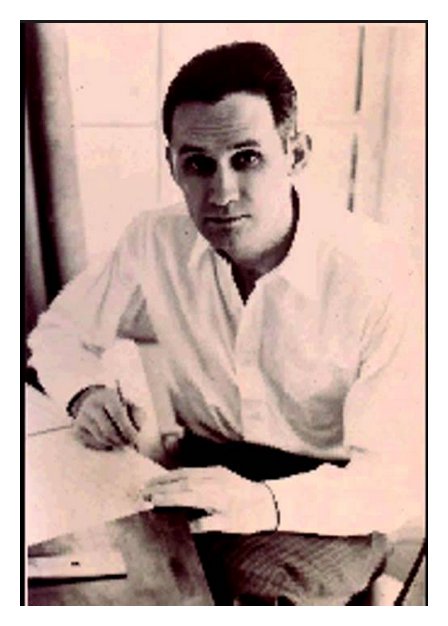

|
Roger Goeb, 82, Who Composed For Orchestra and
Taught Music
By ALLAN KOZINN Published in The New York Times, January 12, 1997 Roger Goeb, a composer whose works were admired for their deft coloration and inherent lyricism, died on Jan. 3 at the Parker Jewish Geriatric Institute in Queens. He was 82 and lived in Rockville Centre, L.I. Mr. Goeb composed prolifically for orchestra and chamber combinations, and from the late 1940's through the early 1960's his music was performed frequently. Leopold Stokowski gave the world premiere of his Third Symphony in a live broadcast concert in 1952 and later recorded it. Mr. Goeb was also active in the American Composers Alliance, which supports the performance, broadcast and recording of contemporary works. Mr. Goeb was born in Cherokee, Iowa, in 1914. After early piano studies, he took up the trumpet, French horn, viola, violin and woodwind instruments. At the University of Wisconsin, he played in jazz bands and completed a degree in agriculture. But after hearing a Beethoven concert by the Budapest String Quartet, he decided to pursue his musical studies more seriously, and in 1938 he enrolled at the Ecole Normale de Musique in Paris, where he studied with Nadia Boulanger. In 1939 he returned to the United States and continued his studies, privately with Otto Luening and at New York University, the Cleveland Institute of Music and the State University of Iowa in Ames, where he taught harmony, counterpoint and orchestration while completing his doctorate and the first of his five symphonies. In the late 1940's he taught orchestral instruments at Bard College, and from 1946 to 1962 he taught a summer course at the Bennington Composers Conference in Vermont. He received Guggenheim Fellowships in 1950 and 1951. Besides his symphonies, Mr. Goeb's works include violin and piano concertos, the ''American Dances'' for string orchestra, a quintet for trombone and strings and four string quartets. Family illness led him to give up composing for more than a decade, starting in 1964, but after the death of his wife and his son, both from multiple sclerosis, he began composing again. The last of his five symphonies was completed in 1981. He composed 25 more works by 1986, when his activity was limited by a stroke. He is survived by his daughters, Marilou Goeb of Manhattan and Kathleen Richards of Chicago. |
| Carlo Gesualdo da Venosa (30 March
1566 – 8 September 1613) was an Italian musician, who was Prince of Venosa
and Count of Conza. As a musician he is best known for writing intensely
expressive madrigals and pieces of sacred music that use a chromatic language
not heard again until the late 19th century. He is also known for his cruelty
and lewdness: the best known fact of his life is his gruesome killing of his
first wife and her lover upon finding them in flagrante delicto. Gesualdo was not kicked out of the church... in fact he is buried within one: Gesualdo died in isolation, at his castle Gesualdo in Avellino, three weeks after the death of his son Emanuele, his first son by his marriage to Maria. One 20th-century biographer has raised the possibility that he was murdered by his wife. He was buried in the chapel of Saint Ignatius, in the Church of the Gesù Nuovo, in Naples. The sepulchre was destroyed in the earthquake of 1688. When the church was rebuilt, the tomb was covered over, and now lies beneath it. The burial plaque, however, remains visible. Perhaps Goeb was thinking about another composer, Alfonso Fontanelli (1557-1622), who (according to the Penguin Companion to Classical Music) wrote intense madrigals on a miniature scale, and was acquainted with Gesualdo. Fontanelli was part of the Ferrarese Court, but was banished on a charge of murder. |
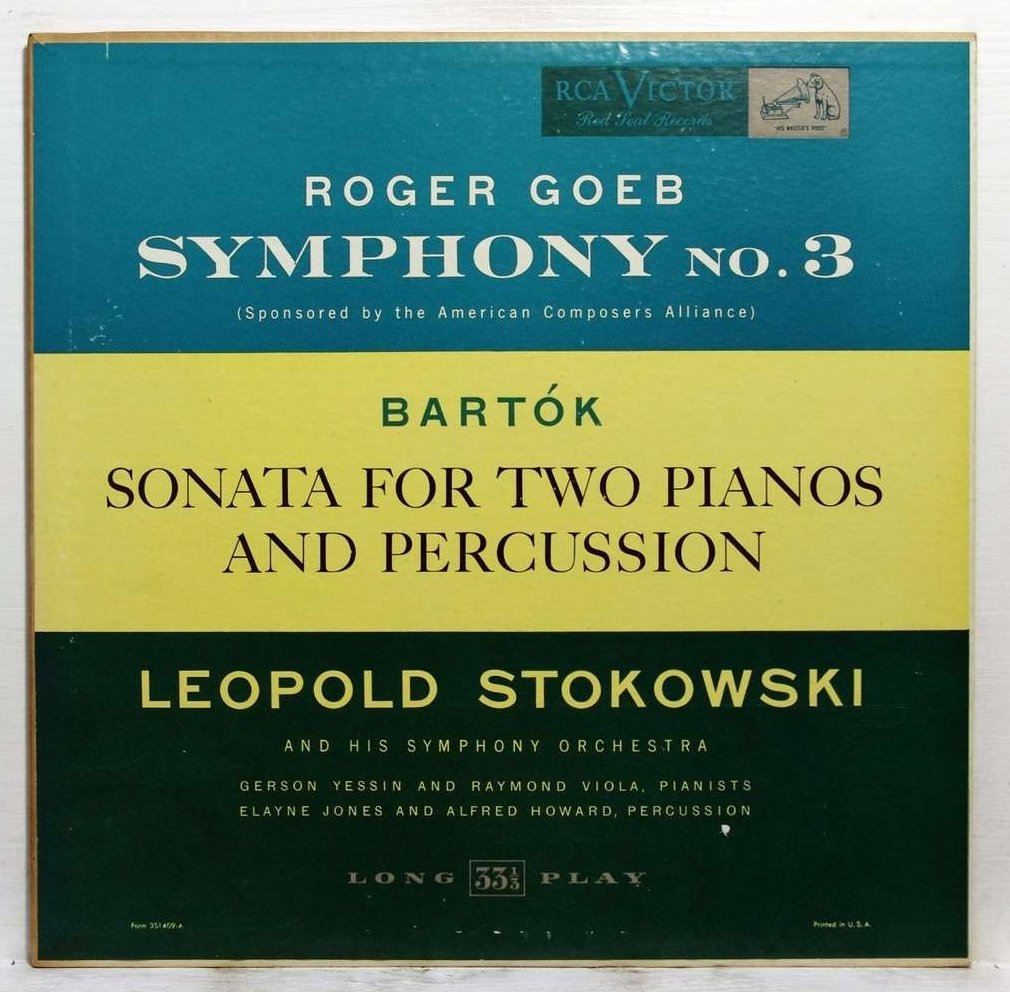
| Carter Harman (1918–2007) was
a composer, writer, and music industry executive. During World War II, Harman
achieved particular distinction for his service in the U.S. Army Air Forces.
He piloted the first mission by a U.S. military helicopter in a combat zone
in 1944. In 1945, the U.S. Army awarded him the Distinguished Flying Cross
for these efforts. Harman later rendered service to the music industry over
a career spanning the 1940s through the 1980s. In 1981, BMI awarded him
their Commendation of Excellence, and the American Composers Alliance awarded
him their Laurel Leaf Award. Harman was born in the New York City Borough of Brooklyn on June 4, 1918. He began musical studies at age nine by learning how to play the clarinet. After graduating from the Morristown School (now Morristown-Beard School) in Morristown, New Jersey, Harman received his bachelor's degree with high honors from Princeton University in Princeton, New Jersey. During his time at Princeton, he studied under composer Roger Sessions, who won two Pulitzer prizes during his career. Harman served as music editor of the Nassau Lit, the college literary magazine at Princeton. He also participated in the choir and band. Following his service in the U.S. military during World War II, Harman completed his master's degree at Columbia University in Manhattan in 1949. He studied under Otto Luening, a German-American pioneer of tape music and electronic music. Before World War II, Harman flew Piper airplanes and Waco aircraft. In 1943, he completed air force training in class 43-C of an Army Air Corps training program in Texas. Harman then served as a flight instructor for primary training. He later joined the first class of helicopter pilots (five in total) of the U.S. Army Air Services. The group trained at Sikorsky Aircraft's headquarters in Stratford, Connecticut to learn to pilot the YR-4B, an early military helicopter. (The R stood for rotary aircraft.) The YR-4B carried no onboard weapons. It featured a cruising speed of 65 miles per hour and a range of 130 miles. On April 21, 1944, the Japanese Imperial Army in Burma shot down a Stinson L-1 Vigilant rescue aircraft piloted by American Murphy Hladovack, which carried three wounded British soldiers. After a Stinson L-5 Sentinel aircraft spotted the group, the 1st Air Commando Group tasked Harman with rescuing them. His YR-4B was the only working helicopter among the four used by the group. The limited range of the YR-4B and small size of its cabin constrained how Harman managed the rescue operation. Harman had to transport the soldiers one by one to a liaison L-5 plane waiting at a designated sandbar and without the aid of weaponry. Over the span of two days, he ferried the soldiers to this plane to bring them to safety. The book Chopper: Firsthand Accounts of Helicopter Warfare, World War II to Iraq chronicles Harman's account of this first mission by a military helicopter. Following World War II, Harman resumed his career as a music critic, which spanned two decades. He wrote articles for The New York Times (1947–1952) and Time Magazine (1952-1957). Harman also composed a ballet titled "Blackface", an opera titled "The Food of Love", and several children's songs. Recorded by Broadway star Mary Martin, his children's songs were released as the album Mary Martin Sings for Children. Starting in the 1950s and continuing into the 1960s, Harman worked as a music critic in Puerto Rico. In 1956 he began his career as a record producer, working with Emory Cook, founder of Cook Records. In 1967, Harman joined Composer Recordings, Inc. (CRI), a producer of contemporary classical music (now part of New World Records), as their executive vice president. He later served as the company's executive director from 1976 to 1981. During his music industry and writing career, Harman served as the sound recorder for the 1963 film Lord of the Flies. Directed by Peter Brook and produced by Lewis M. Allen, the film represented a British adaptation of William Golding's 1954 novel with the same name. Harman also authored three books. His first book discussed music history up through the Jazz Age. Harman's later books examined the West Indies, a collaboration with his wife, Helen Scott Harman and editors at Life magazine (1963), and building activities to construct skyscrapers. 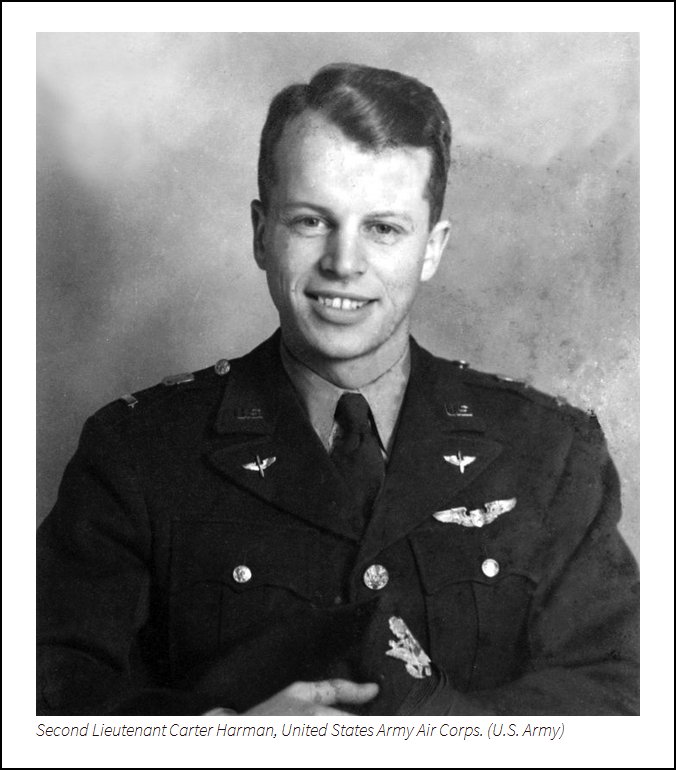
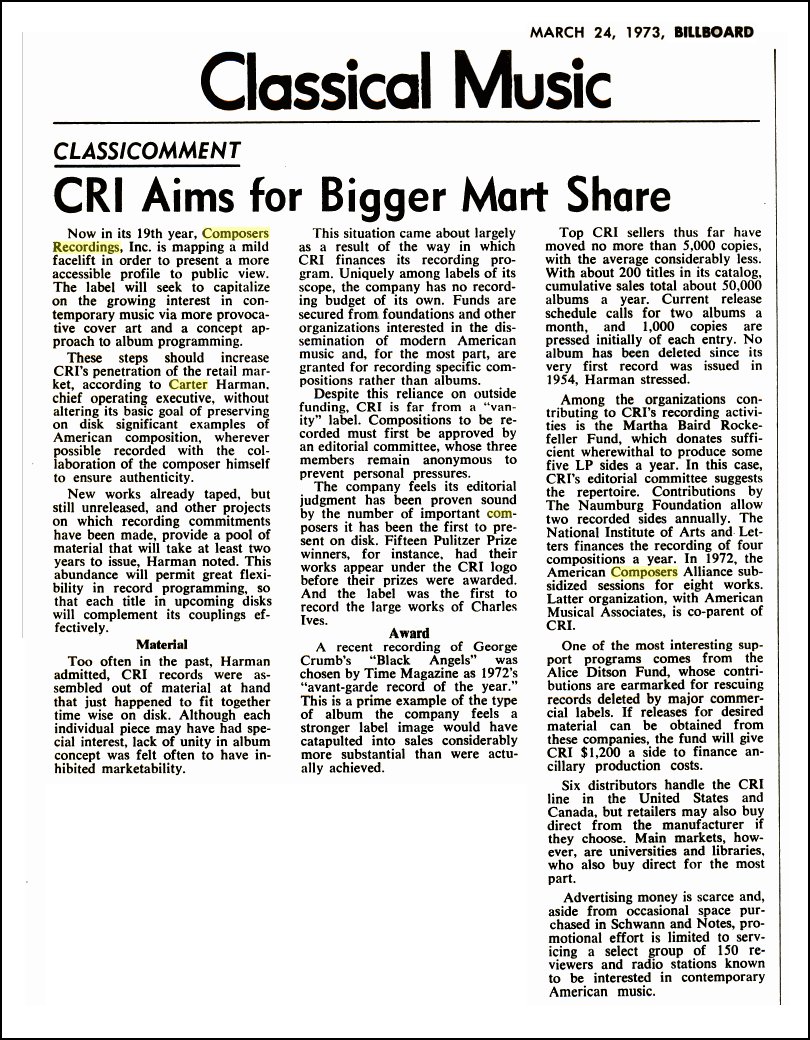
Carter Harman, 88, Composer, Music Critic and
Record Producer, Dies
By ALLAN KOZINN Published in The New York Times, January 31, 2007 Carter Harman, a composer, music critic, author and record producer, died on Jan. 23 in Stowe, Vt. He was 88 and lived in Waterbury, Vt. His death was announced by his daughter, Lisa Diomande. Mr. Harman’s breadth of interests led him to write profiles of jazz greats like Duke Ellington and Rosemary Clooney while composing his own operas and symphonic works, and to write a children’s book about skyscrapers at a time when he was also producing recordings of avant-garde music. He worked for two decades as a music critic, first for The New York Times from 1947 to 1952, and for Time magazine from 1952 to 1957, and then in Puerto Rico through the mid-1960s. His first book, “A Popular History of Music — From Gregorian Chant to Jazz,” was published by Dell in 1956. His other books include “The West Indies,” a collaboration with his wife, Helen Scott Harman, and editors at Life magazine (1963); and “A Skyscraper Goes Up” (1973). After he left Time, Mr. Harman was engaged to help Ellington write his autobiography and collected about 20 hours of interviews before withdrawing from the project when it became clear to Mr. Harman that he and Ellington were at cross purposes. “I thought I was writing the ‘secret’ Ellington,” Mr. Harman said in 1991, “and he had no such idea. He wanted to write a book that was a print version of the public Duke Ellington.” Mr. Harman was born in Brooklyn on June 14, 1918, and began his musical studies as a clarinetist, at the age of 9. He studied composition with Roger Sessions at Princeton University, where he received his bachelor’s degree in 1940. In World War II, he joined the Army Air Forces, becoming a helicopter pilot. In 1944, he was the first to accomplish a rescue by helicopter behind enemy lines, extracting three Allied soldiers from a jungle in Burma; an account appears in “Chopper” by Robert F. Dorr (Berkley, 2005). Mr. Harman was awarded the Distinguished Flying Cross. After the war, Mr. Harman resumed his musical studies at Columbia University, where he was a student of Otto Luening. He completed his master’s degree in 1949, and began composing, at Mr. Luening’s advice, with a group of simple children’s songs that were recorded by Mary Martin; the record was titled “Mary Martin Sings for Children.” But he wrote on a larger scale too: his catalog includes a ballet (“Blackface,” from 1947) and an opera (“The Food of Love,” 1949-51) and several orchestral works. He began to compose electronic music in 1954 and took it up again 20 years later, in “Alex and the Singing Synthesizer.” In the mid-1960s, Mr. Harman became a record producer, with a special interest in contemporary music. In 1967, he became executive vice president of CRI Records, which specialized in works by American composers. He was the label’s executive director from 1976 to 1984. |
Maurice Wilk was a well-known American violinist who performed as a member of the Alma Trio from 1953 until his sudden death in February, 1963 at the age of 38. He was the original violinist in the Bach Aria Group during the late 1940s. The other original members of the Bach Aria Group were Bernard Greenhouse (Cello); Menahem Pressler (Piano); and Robert Bloom (oboe). During the 1950s he was a faculty member at Columbia University in New York City. 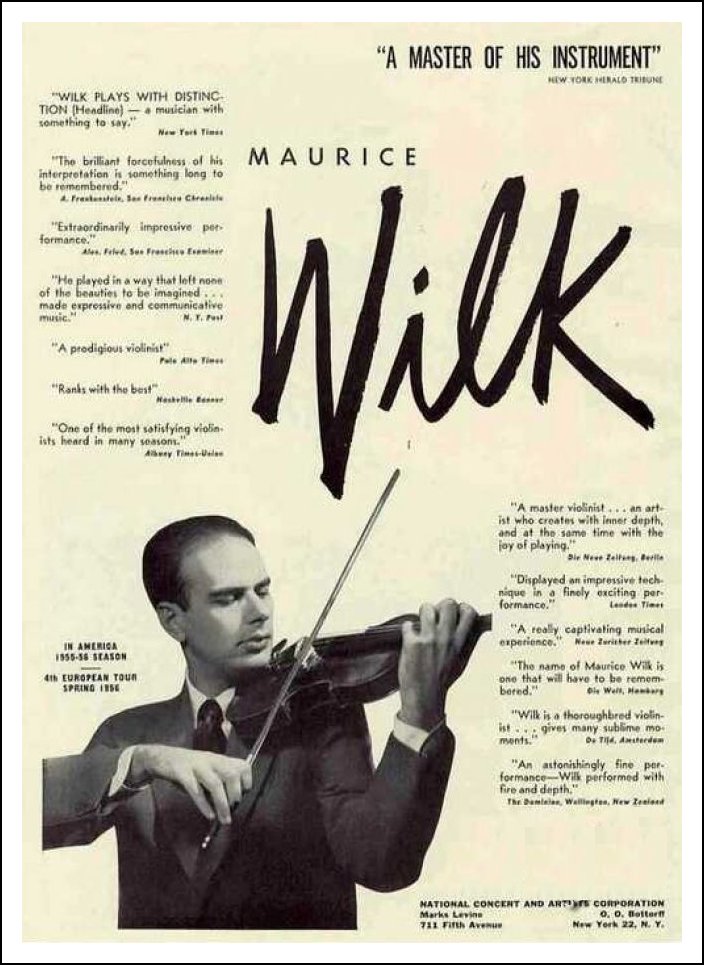
|
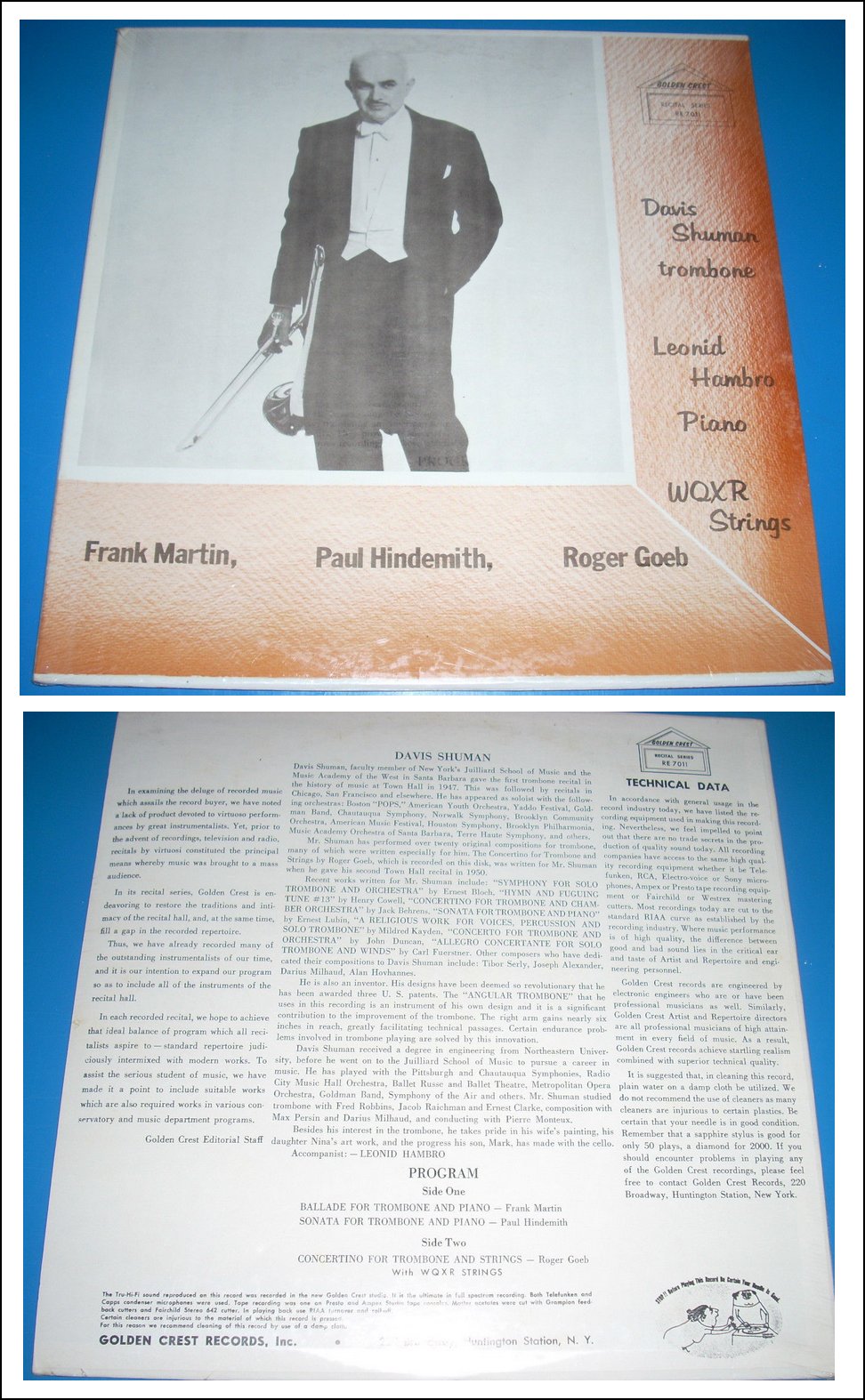
© 1989 Bruce Duffie
This conversation was recorded on the telephone on January 15, 1989. Portions were broadcast on WNIB later that year, and again in 1994 and 1999. This transcription was made in 2016, and posted on this website at that time. My thanks to British soprano Una Barry for her help in preparing this website presentation.
To see a full list (with links) of interviews which have been transcribed and posted on this website, click here. To read my thoughts on editing these interviews for print, as well as a few other interesting observations, click here.
Award - winning broadcaster Bruce Duffie was with WNIB, Classical 97 in Chicago from 1975 until its final moment as a classical station in February of 2001. His interviews have also appeared in various magazines and journals since 1980, and he now continues his broadcast series on WNUR-FM, as well as on Contemporary Classical Internet Radio.
You are invited to visit his website for more information about his work, including selected transcripts of other interviews, plus a full list of his guests. He would also like to call your attention to the photos and information about his grandfather, who was a pioneer in the automotive field more than a century ago. You may also send him E-Mail with comments, questions and suggestions.